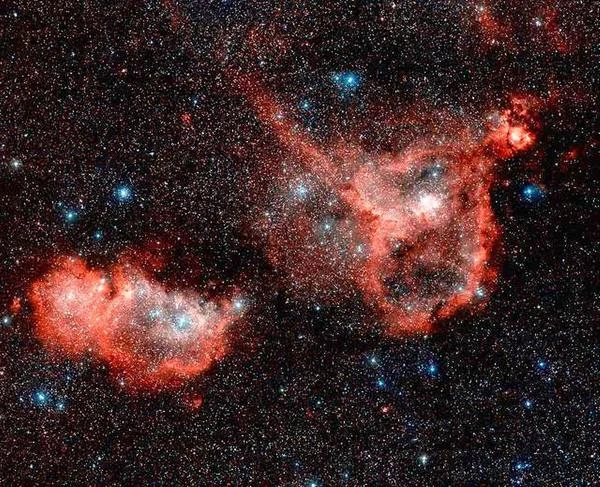
The Heart Nebula (IC 1805) and the Soul Nebula (IC 1848) are located in the constellation Cassiopeia, about 7,500 light-years from Earth, in the Perseus Arm of the Milky Way. Each spans nearly 200 light-years and is part of a vast molecular cloud.
Observable with telescopes equipped with Hα filters, they appear as a double cosmic structure: the Heart and the Soul. These nebulae are particularly bright in the ionized hydrogen line, producing the characteristic red color seen in astronomical photographs.
N.B.:
Ionized hydrogen, denoted H II, is a hydrogen atom that has lost its only electron due to ultraviolet radiation from massive stars. This plasma, consisting solely of protons and free electrons, is the origin of H II regions, true "stellar nurseries," as it reveals star-forming zones. The energy required to ionize hydrogen is 13.6 eV.
The "Heart and Soul Nebulae" are two immense clouds of gas and dust in our galaxy. They glow because their hydrogen atoms are strongly excited by the light of very hot and massive stars. These regions are also stellar cradles, where new stars are born from the collapse of denser regions of gas and dust.
Beyond their visual beauty, these nebulae are the stage for complex physical processes: starlight alters matter, gas movements sculpt the clouds, and the chemistry of the interstellar medium prepares the formation of future stars. They thus offer a unique glimpse into how the Universe recycles its matter to create new generations of stars.
To study the nebulae, astronomers analyze the light they emit. Certain spectral lines, such as the famous Hα line of hydrogen or those of oxygen ([O III] at 500.7 nm) and nitrogen ([N II] at 658.4 nm), act as true "probes." They allow the determination of two key quantities: the temperature of the gas and its electron density. By comparing the relative intensity of these lines and using photo-ionization models, one can deduce the efficiency of the stellar radiation ionizing the gas, as well as the precise physical conditions within the nebula.
In nebulae, dust plays an essential role. It absorbs some of the highly energetic light from massive stars and re-emits this energy as infrared radiation. This process heats the environment and influences the temperature distribution. Moreover, on the surface of ice-covered dust grains, chemical reactions can occur, giving rise to complex molecules, sometimes considered as building blocks of life.
In the densest regions of nebulae, gravity can overcome the forces that keep the gas in equilibrium (heat, turbulence, magnetic fields). When this happens, matter collapses on itself and forms "cores" that will become stars. The minimum size of these cores is defined by what astrophysicists call the "Jeans length," a criterion that sets the mass beyond which a cloud can collapse to form a new star.
To understand these processes, astronomers combine different wavelengths: visible light (e.g., the Hα line of hydrogen), infrared, and radio waves. By comparing these images, one can map the dust, measure light extinction, track gas movements, and thus link the presence of forming stars to ionization and the distribution of matter in the nebula.
This table highlights that the Heart and Soul Nebulae are part of a large family of giant H II regions, often linked to young open clusters rich in massive stars.
We see that the Heart and Soul Nebulae are among the most massive (\(10^{5}\ M_{\odot}\)), comparable to the Rosette, and much richer in gas than Orion or the Trifid, which are smaller but well-studied due to their proximity.
| Nebula | Designation | Constellation | Distance (light-years) | Apparent size | Gas mass (M☉) | Particularities |
|---|---|---|---|---|---|---|
| Heart Nebula | IC 1805 | Cassiopeia | ≈ 7,500 | ~ 2° | ~ 2 × 105 | H II region ionized by the open cluster Melotte 15 |
| Soul Nebula | IC 1848 | Cassiopeia | ≈ 7,500 | ~ 2° | ~ 1.5 × 105 | Known for its "Bok globules" (star-forming sites) |
| Eagle Nebula | Messier 16 | Serpens | ≈ 6,500 | 70′ × 50′ | ~ 8 × 104 | Home to the famous "Pillars of Creation" |
| Orion Nebula | Messier 42 | Orion | ≈ 1,350 | 65′ × 60′ | ~ 2 × 104 | Closest H II region to Earth, a stellar formation laboratory |
| Rosette Nebula | NGC 2237 | Monoceros | ≈ 5,200 | 1.3° | ~ 1 × 105 | Large cavity carved by a central open cluster (NGC 2244) |
| Lagoon Nebula | Messier 8 | Sagittarius | ≈ 4,100 | 90′ × 40′ | ~ 6 × 104 | Features dark dust structures in contrast |
| Trifid Nebula | Messier 20 | Sagittarius | ≈ 5,200 | 28′ | ~ 1 × 104 | Rare mix of emission, reflection, and absorption |
In astronomy, the term nebula is quite generic: it simply refers to an interstellar cloud of gas and dust, but there are several distinct physical types:
| Type | Main composition | Energy source | Observed appearance | Examples |
|---|---|---|---|---|
| H II Nebulae | Ionized hydrogen (H⁺), gas + dust | Intense UV radiation from young massive stars (O, B) | Bright regions in Hα, often red in color | Orion (M42), Rosette, Heart and Soul |
| Dark Nebulae | Neutral gas (H₂) and opaque dust | Absorption and scattering of light from background stars | Dark silhouettes contrasting with the starry background | Coalsack, Horsehead, Barnard 68 |
| Planetary Nebulae | Gas ejected from dying stars (H, He, C, O…) | UV radiation from the central white dwarf | Bright rings or shells, symmetrical | Ring (M57), Helix, Cat's Eye |
| Supernova Remnants | Ejected gas enriched with heavy elements (O, Si, Fe…) | Kinetic energy of the explosion + radiation from the central pulsar | Luminous filaments, expanding structures | Crab (M1), Veil, Cas A |